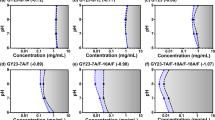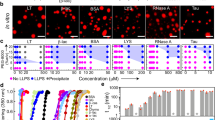Abstract
The liquid-liquid phase separation of biopolymers in living cells contains multiple interactions and occurs in a dynamic environment. Resolving the regulation mechanism is still a challenge. In this work, we designed a series of peptides (XXLY)6SSSGSS and studied their complexation and coacervation behavior with single-stranded oligonucleotides. The “X” and “Y” are varied to combine known amounts of charged and non-charged amino acids, together with the introduction of secondary structures and pH responsiveness. Results show that the electrostatic interaction, which is described as charge density, controls both the strength of complexation and the degree of chain relaxation, and thus determines the growth and size of the coacervates. The hydrophobic interaction is prominent when the charges are neutralized. Interestingly, the secondary structures of peptides exhibit profound effect on the morphology of the phases, such as solid phase to liquid phase transition. Our study gains insight into the phase separation under physiological conditions. It is also helpful to create coacervates with desirable structures and functions.
Similar content being viewed by others
Data Availability Statement
The related data (DOI: https://doi.org/10.57760/sciencedbij00189i00004) for this paper is available in the Data Repository of China Association for Science and Technology (https://www.scidb.cn/s/jAvIzq).
References
Meka, V. S.; Singe, M. K. G.; Pichika, M. R.; Nali, S. R.; Kolapaili, V. R. M.; Kesharwani, P. A comprehensive review on polyelectrolyte complexes. Drug Discov. Today 2017, 22, 1697–1706.
Liu, H. D.; Sato, T. Polymer colloids formed by polyelectrolyte complexation of vinyl polymers and polysaccharides in aqueous solution. Chinese J. Polym. Sci. 2013, 31, 39–49.
Shi, X. H.; Chen, L.; Liu, B. W.; Long, J. W.; Xu, Y. J.; Wang, Y. Z. Carbon fibers decorated by polyelectrolyte complexes toward their epoxy resin composites with high fire safety. Chinese J. Polym. Sci. 2018, 36, 1375–1384.
Huang, W. T.; Li, J. F.; Liu, D. Z.; Tan, S. X.; Zhang, P. F.; Zhu, L. P.; Yang, S. G. Polyelectrolyte complex fiber of alginate and poly(diallyldimethylammonium chloride): humidity-induced shape memory and mechanical transition. ACS Appl. Polym. Mater. 2020, 2, 2119–2125.
Huang, W. T.; Liu, D. Z.; Zhu, L. P.; Yang, S. G. A salt controlled scalable approach for formation of polyelectrolyte complex fiber. Chinese J. Chem. 2020, 38, 465–470.
Yewdall, N. A.; André, A. A. M.; Lu, T. M.; Spruijt, E. Coacervates as models of membraneless organelles. Curr. Opin. Colloid In. 2021, 52, 101416.
Gao, N.; Mann, S. Membranized coacervate microdroplets: from versatile protocell models to cytomimetic materials. Acc. Chem. Res. 2023, 56, 297–307.
Mu, W. J.; Ji, Z.; Zhou, M. S.; Wu, J. Z.; Lin, Y. Y.; Qiao, Y. Membrane-confined liquid-liquid phase separation toward artificial organelles. Sci. Adv. 2021, 7, eabf9000.
Moreau, N. G.; Martin, N.; Gobbo, P.; Tang, T. Y. D.; Mann, S. Spontaneous membrane-less multi-compartmentalization via aqueous two-phase separation in complex coacervate micro-droplets. Chem. Commun. 2020, 56, 12717–12720.
Blocher, W. C.; Perry, S. L. Complex coacervate-based materials for biomedicine. Wires Nanomed Nanobi. 2017, 9, e1442.
McTigue, W. C. B.; Perry, S. L. Protein encapsulation using complex coacervates: what nature has to teach us. Small 2020, 16, 1907671.
Sun, Y.; Lau, S. Y.; Lim, Z. W.; Chang, S. C.; Ghadessy, F.; Partridge, A.; Miserez, A. Phase- separating peptides for direct cytosolic delivery and redox-activated release of macromolecular therapeutics. Nat. Chem. 2022, 14, 274–283.
Ban, E.; Kim, A. Coacervates: recent developments as nanostructure delivery platforms for therapeutic biomolecules. Int. J. Pharmaceut. 2022, 624, 122058.
Johnson, N. R.; Wang, Y. D. Coacervate delivery systems for proteins and small molecule drugs. Expert Opin. Drug. Del. 2014, 11, 1829–1832.
Wang, J.; Abbas, M.; Huang, Y.; Wang, J.; Li, Y. Redox-responsive peptide-based complex coacervates as delivery vehicles with controlled release of proteinous drugs. Commun. Chem. 2023, 6, 243.
Turgeon, S. L.; Schmitt, C.; Sanchez, C. Protein-polysaccharide complexes and coacervates. Curr. Opin. Colloid. In. 2007, 12, 166–178.
Chen, S. J.; Guo, Q.; Yu, J. Bio-inspired functional coacervates. Aggregate 2022, 3, e293.
Stewart, R. J.; Wang, C. S.; Shao, H. Complex coacervates as a foundation for synthetic underwater adhesives. Adv. Colloid Interface 2011, 167, 85–93.
Forooshani, P. K.; Lee, B. P. Recent approaches in designing bioadhesive materials inspired by mussel adhesive protein. J. Polym. Sci., Part A: Polym. Chem. 2017, 55, 9–33.
Rumyantsev, A. M.; Jackson, N. E.; de Pablo, J. J. Polyelectrolyte complex coacervates: recent developments and new frontiers. Annu. Rev. Conden. Ma. P 2021, 12, 155–176.
Oparin, A. I. The Origin of Life. MacMillan: New York, 1938, 1–6.
Fry, I. The origins of research into the origins of life. Endeavour 2006, 30, 24–28.
Gözen, I.; Köksal, E. S.; Poldsalu, I.; Xue, L.; Spustova, K.; Pedrueza-Villalmanzo, E.; Ryskulov, R.; Meng, F. D.; Jesorka, A. Protocells: milestones and recent advances. Small 2022, 18, 2106624.
Li, F.; Lin, Y. Y.; Qiao, Y. Regulating FUS liquid-liquid phase separation via specific metal recognition. Chinese J. Polym. Sci. 2022, 40, 1043–1049.
Veis, A. A review of the early development of the thermodynamics of the complex coacervation phase separation. Adv. Colloid Interface 2011, 167, 2–11.
Sing, C. E.; Perry, S. L. Recent progress in the science of complex coacervation. Soft Matter 2020, 16, 2885–2914.
Overbeek, J. T. G. a. V., M. J. Phase separation in polyelectrolyte solutions. Theory of complex coacervation. J. Cell. Comp. Physiol. 1957, 49, 7–26.
Michaeli, I.; Overbeek, J. T. G.; Voorn, M. J. Phase separation of polyelectrolyte solutions. J. Polym. Sci. 1957, 23, 443–450.
Shi, A. C.; Noolandi, J. Theory of inhomogeneous weakly charged polyelectrolytes. Macromol. Theor. Simul. 1999, 8, 214–229.
Wang, Q.; Taniguchi, T.; Fredrickson, G. H. Self-consistent field theory of polyelectrolyte systems. J. Phys. Chem. B 2004, 108, 6733–6744.
Shusharina, N. P.; Zhulina, E. B.; Dobrynin, A. V.; Rubinstein, M. Scaling theory of diblock polyampholyte solutions. Macromolecules 2005, 38, 8870–8881.
Wang, Z. W.; Rubinstein, M. Regimes of conformational transitions of a diblock polyampholyte. Macromolecules 2006, 39, 5897–5912.
Sing, C. E. Development of the modern theory of polymeric complex coacervation. Adv. Colloid Interface 2017, 239, 2–16.
Tabandeh, S.; Leon, L. Engineering peptide-based polyelectrolyte complexes with increased hydrophobicity. Molecules 2019, 24, 868.
Huang, J.; Laaser, J. E. Charge density and hydrophobicity-dominated regimes in the phase behavior of complex coacervates. ACS Macro Lett. 2021, 10, 1029–1034.
Vieregg, J. R.; Lueckheide, M.; Marciel, A. B.; Leon, L.; Bologna, A. J.; Rivera, J. R.; Tirrell, M. V. Oligonucleotide-peptide complexes: phase control by hybridization. J. Am. Chem. Soc. 2018, 140, 1632–1638.
Pacalin, N. M.; Leon, L.; Tirrell, M. Directing the phase behavior of polyelectrolyte complexes using chiral patterned peptides. Eur. Phys. J.-Spec. Top. 2016, 225, 1805–1815.
Cheng, C.; Tu, Z. C.; Wang, H. pH-induced complex coacervation of fish gelatin and carboxylated chitosan: phase behavior and structural properties. Food Res. Int. 2023, 167, 112652.
Kaibara, K.; Okazaki, T.; Bohidar, H. B.; Dubin, P. L. pH-induced coacervation in complexes of bovine serum albumin and cationic polyelectrolytes. Biomacromolecules 2000, 1, 100–107.
Priftis, D.; Tirrell, M. Phase behaviour and complex coacervation of aqueous polypeptide solutions. Soft Matter 2012, 8, 9396–9405.
Perry, S. L.; Li, Y.; Priftis, D.; Leon, L.; Tirrell, M. The effect of salt on the complex coacervation of vinyl polyelectrolytes. Polymers 2014, 6, 1756–1772.
Love, C.; Steinkühler, J.; Gonzales, D. T.; Yandrapalli, N.; Robinson, T.; Dimova, R.; Tang, T. Y. D. Reversible pH-responsive coacervate formation in lipid vesicles activates dormant enzymatic reactions. Angew. Chem. Int. Ed. 2020, 59, 5950–5957.
Zhou, J.; Wan, Y.; Cohen Stuart, M. A.; Wang, M.; Wang, J. Effects of control factors on protein-polyelectrolyte complex coacervation. Biomacromolecules Article ASAP.
Mart, R. J.; Osborne, R. D.; Stevens, M. M.; Ulijn, R. V. Peptide-based stimuli-responsive biomaterials. Soft Matter 2006, 2, 822–835.
Ulijn, R. V.; Woolfson, D. N. Peptide and protein based materials in 2010: from design and structure to function and application. Chem Soc Rev 2010, 39, 3349–3350.
Wang, L.; Wang, N. X.; Zhang, W. P.; Cheng, X. R.; Yan, Z. B.; Shao, G.; Wang, X.; Wang, R.; Fu, C. Y. Therapeutic peptides: current applications and future directions. Signal Transduct Tar. 2022, 7, 48.
Bai, Q. W.; Zhang, Q. F.; Jing, H. R.; Chen, J. X.; Liang, D. H. Liquid-Liquid Phase Separation of Peptide/Oligonucleotide Complexes in Crowded Macromolecular Media. J. Phys. Chem. B 2021, 125, 49–57.
Kyte, J.; Doolittle, R. F. A simple method for displaying the hydropathic character of a protein. J. Mol. Biol. 1982, 177, 105–132.
Stothard, P. The sequence manipulation suite: JavaScript programs for analyzing and formatting protein and DNA sequences. Biotechniques 2000, 28, 1102–1104.
Lehninger, A. L.; Nelson, D. L.; Cox, M. M. Principles of Biochemistry. Worth Publishers: New York, 1982, 615–643.
Wang, H.; Davis, R. H. Collective effects of gravitational and Brownian coalescence on droplet growth. J Colloid Interf. Sci. 1996, 178, 47–52.
Acknowledgments
This work was financially supported by the National Natural Science Foundation of China (No. 21973002). The measurements of LCSM were performed at the Analytical Instrumentation Center of Peking University. We acknowledge the assistance and support from PKUAIC (Dr. Yan Guan).
Author information
Authors and Affiliations
Corresponding author
Ethics declarations
The authors declare no interest conflict.
Electronic supplementary material
Rights and permissions
About this article
Cite this article
Ren, TH., Liang, DH. Polyelectrolyte Complexes and Coacervates Formed by De novo-Designed Peptides and Oligonucleotide. Chin J Polym Sci (2024). https://doi.org/10.1007/s10118-024-3096-6
Received:
Accepted:
Published:
DOI: https://doi.org/10.1007/s10118-024-3096-6




